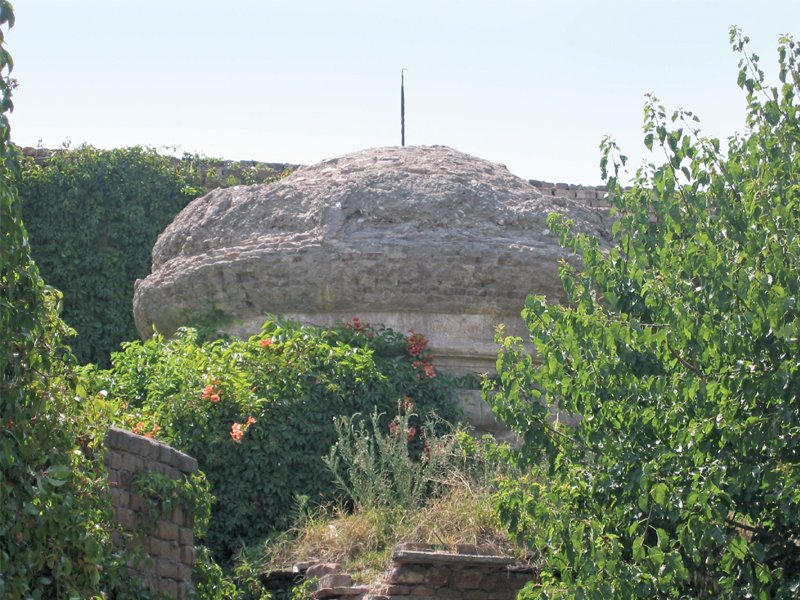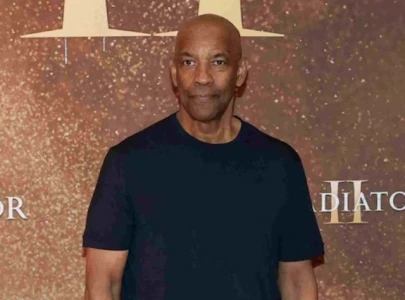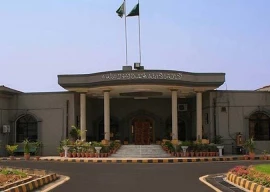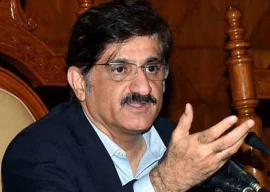
A signboard hangs near the pool, telling visitors a natural steam runs through it since 1675. For centuries, this stream was more than just a swimming hole to locals. It was among the four most sacred places for Hindus located in Peshawar – Panj Tirath (the five ponds), the centuries-old Guru Gorkhnath temple in Gorghatri, Aasamai temple and Khushal Bagh.

This is all that remains of a once sacred site in the city. In pre-partition days, the Panj Tirath complex included ponds, temples, residential complexes and sprawling lawns. PHOTO: RIAZ AHMED/EXPRESS
However, back then, Khushal Bagh was better known as Gorakh Degi or the pond of Gorakh. For generations, Hindus living in Peshawar and other parts of the province visited the stream to take a bath and wash away their sins in its holy water.
“It is associated with the Guru Gorkhnath temple in Gorghatri. It is said our guru used to jump into the well inside the temple and appear in Gorakh Degi on Warsak Road miles away. So both places are holy for us,” Haroon Sarbdyal, a local Hindu elder told The Express Tribune.
Gorakh Degi, along with most other religious sites in Peshawar, was abandoned after the partition of the sub-continent in 1947 as only the disadvantaged-caste adherents were left on this side of the border. Traditionally, they were only allowed to pray inside their own temples and were prohibited from worshipping at the holiest of sites of the higher-caste Hindus.
The 160-year-old Guru Gorkhnath temple was named after a Hindu spiritual leader Guru Goraknath. After the local Hindu community diminished post partition, the temple remained silent and sans rituals until the Peshawar High Court handed over its custody to the Hindu community early 2012.
The Panj Tirath on the Grand Trunk Road met with a far worse fate. It was razed down and the Khyber-Pakhtunkhwa (K-P) Chamber of Commerce and Industry was built in its place in the 1970s.
“I still remember the ponds of Panj Tirath. I was a student of Government High School City No 2 and was a scout. It was routine for us to cross the road and go to the ponds to practice there,” remarked Zahoor Durrani, who is considered an authority on tourism and the history of K-P.
In his days, the ponds had clean water and an old man would always be present, “who told children the water of Panj Tirath was holy and sacred.”
“I still remember that old man and a milk seller who lived nearby and whose milk was famous in the city. Very good memories of days bygone and a childhood are attached with the pond,” recalled Durrani.

Then suddenly in the 1970s, Durrani added, the ponds were razed and a building called Sarhad Chamber of Commerce and Industry was constructed there. The Asamai temple near Lady Reading Hospital (LRH) remains closed and worshipers are not allowed to enter. Locals claim the temple is one of just two of its kind in the world; a temple of the same name could also be found at the foothills of the Koh-i-Asamai in Kabul.
“As far as my knowledge extends, there are only two historic temples of Asamai – a holy woman. One is located in Peshawar and other in Kabul. It is said the Kabul temple has a jute or flame which has been burning for centuries,” narrated Sarbdyal. “However, both are out of worshippers’ reach these days.”
“Our community was lucky enough. The centuries-old temple in Gorghatri was handed over to us a few years ago,” but, he added, the other two holy sites – Asamai temple and Gorakh Degi – remain under the government’s control.
“Yes, the Panj Tirath is lost forever, but the other two places still exist and should be handed over to the Hindu community,” urged Sarbdyal.
Published in The Express Tribune, June 20th, 2013.
COMMENTS (10)
Comments are moderated and generally will be posted if they are on-topic and not abusive.
For more information, please see our Comments FAQ

1732090022-0/Elmo-and-Amelia-(1)1732090022-0-165x106.webp)
1725523665-0/Minecraft-Movie-(1)1725523665-0-165x106.webp)

1732089759-0/BeFunky-collage-(75)1732089759-0-165x106.webp)

1732091859-0/BeFunk_§_]__-(10)1732091859-0.jpg)
1732083221-0/BeFunk_§_]__-(8)1732083221-0.jpg)









you dont need place of worship to worship your lord and by the way none of us even know whether our lords even existed or not let me put some points 1 religion is nothing but set of some rules to keep a society in order and every religion has some demerits which become reason for its demise in case of hindus it is caste system and in case of islam it is fundamentalism and also its rules which are prone to wrong manipulation.
2 its one's own understanding to decide who is desirable his neighbour (from other religion) or some cleric sitting in some temple or mosque. due to this orthodox thinking people in 1947 gave right to politicians like jinnah and nehru to divide india.
3 and by the way our great leaders gandhi and jinnah they didn't have any means to partition India peacefully they didn't have enough military to provide a safe passage to immigrants they said anybody who doesn't want to migrate to other side can stay, so what was the need for a partition they didn't have means to rehabilitate refugees but they have power to divide india which we gave them hindus and muslims only way out of this is education if nobody is going there for worship construct some more schools at that site
@I am a Khan: They have been hit by a natural disaster, man. They have not gone into decline. They will be restored to their original conditions once the weather improves. How can you compare them with the temples in Peshawar?
@I am a Khan: Jeyo aur jeenay do. Natural calamities happen. Don't be holier than the pope. It is a expression. Have a good day. Rab rakha
@I am a Khan: bro it was done by natural calamities not by any person but temples in Pakistan is destroyed by Muslim fundamentalist...there is difference...i guess..
I born and living in peshawar for 36 years. thanks to this article I came to know, we have holy sites of Hindus in our city. It's a great asset and should not be destroyed. I hope our new imran khan's government in province will take some action to preserve these assets .
Its also the government's duty to take care of these sites. Please give them to the archological society of Pak . All visits for social /religious/ tourist interest between the two countreis should be openly allowed.
You talk of Peshawar, even in India the 4 Hindu Shrines (Char Dhaam) are in decline after the recent devastating floods in Uttarakhand and surrounding areas.
Asamai.... thanks to this article, I would have never known the origins of this name, a place in whose arteries I have walked and passed by on road. Never knew there was a temple there. Felt really deprived reading this. What an oblivious lot we are.
Unfortunately, if shias and ahmedi's don't stand a chance in Pakistan, what chance do hindu's have? But I'm sure we mere humans don't have to protect god's abode. God will punish those who destroy innocents.
Those 2 remaining temples should be handed over to the Hindu community. It should be renovated because it is part of Peshawar's heritage, my suggestion would be to raise funds for it through the Hindu as well as the Muslim communities, keep the government out of it.